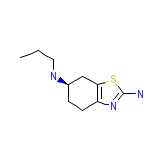Pramipexol




Categorie
Pramipexol Les marques, Pramipexol Analogs
Pramipexol Les marques melange
Pramipexol Formule chimique
Pramipexol RX lien
Pramipexol FDA fiche
Pramipexol msds (fiche de securite des materiaux)
Pramipexol Synthese de reference
Pramipexol Poids moleculaire
Pramipexol Point de fusion
Pramipexol H2O Solubilite
Pramipexol Etat
Pramipexol LogP
Pramipexol Formes pharmaceutiques
Pramipexol Indication
Pramipexol Pharmacologie
Pramipexol Absorption
Pramipexol Toxicite
Pramipexol Information pour les patients
Patients should be instructed to take MIRAPEX only as prescribed.
Patients should be informed that hallucinations can occur and that the elderly are at a higher risk than younger patients with Parkinson 's disease.
Patients may develop postural (orthostatic) hypotension, with or without symptoms such as dizziness, nausea, fainting or blackouts, and sometimes, sweating. Hypotension may occur more frequently during initial therapy. Accordingly, patients should be cautioned against rising rapidly after sitting or lying down, especially if they have been doing so for prolonged periods and especially at the initiation of treatment with MIRAPEX.
Patients should be advised that MIRAPEX may cause somnolence and that they should neither drive a car nor operate other complex machinery until they have gained sufficient experience on MIRAPEX to gauge whether or not it affects their mental and/or motor performance adversely. Because of the possible additive sedative effects, caution should also be used when patients are taking other CNS depressants in combination with MIRAPEX.
Because the teratogenic, potential of pramipexole has not been completely established in laboratory animals, and because experience in humans is limited, patients should be advised to notify their physicians if they become pregnant or intend to become pregnant during therapy.
Because of the possibility that pramipexole may be excreted in breast milk, patients should be advised to notify their physicians if they intend to breast-feed or are breast-feeding an infant.
If patients develop nausea, they should be advised that taking MIRAPEX with food may reduce the occurrence of nausea.














